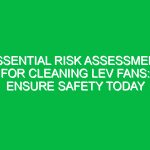Introduction
Hello everyone! Today, we’re going to hold a toolbox talk focused on an often-overlooked yet crucial topic in our work Environment: Mosquitos. While these tiny creatures may seem like a nuisance, they can pose significant health risks, especially in areas where we work outdoors. Understanding how to protect ourselves from Mosquitos is not just beneficial for our personal health but also essential for maintaining a safe working environment. Let’s dive into some important Safety tips, the risks associated with Mosquitos, and how we can effectively combat them in our daily operations.
The Importance of Mosquito Awareness
Mosquitos are more than just an annoyance; they are known vectors for various diseases, including West Nile virus, Zika virus, and malaria. Each year, millions of people suffer from illnesses transmitted by these insects. In our line of work, especially if we are involved in construction, landscaping, or any outdoor activities, it is critical to be aware of the risks they pose. By staying informed and taking practical steps to protect ourselves, we can significantly reduce the likelihood of mosquito-borne diseases.
Understanding Mosquito Behavior
Before we discuss Safety tips, it’s essential to understand how Mosquitos behave. These insects are most active during dawn and dusk. They are attracted to warmth and carbon dioxide, which we naturally emit while working. Additionally, standing water is a breeding ground for Mosquitos, making it crucial to identify and address potential breeding sites in our work areas.
Common Breeding Grounds
- Puddles and stagnant water in construction sites
- Water-filled containers or tires
- Clogged gutters
- Plants with standing water
Identifying these areas is the first step in mosquito management. Now, let’s move on to some essential safety tips.
Essential Mosquito Safety Tips
1. Wear Protective Clothing
One of the simplest and most effective ways to protect yourself from Mosquitos is by wearing the right clothing. Long sleeves, long pants, and socks can help reduce skin exposure. Choosing light-colored clothing can also deter Mosquitos, as they are attracted to dark colors.
2. Use Insect Repellent
Using EPA-registered insect repellents that contain DEET, picaridin, or oil of lemon eucalyptus is highly recommended. Apply the repellent to exposed skin and reapply according to the product instructions, especially after sweating or washing your skin. Remember, proper application is key to effectiveness.
3. Eliminate Breeding Sites
As mentioned earlier, eliminating standing water is crucial in controlling Mosquitos. Conduct regular inspections of the worksite to identify areas where water may collect. If you see any standing water, take immediate action to remove it or cover it to prevent Mosquitos from breeding.
Encouraging Team Participation
It’s vital that everyone on the team understands their role in mosquito safety. During our Toolbox Talk, let’s discuss how we can work together to minimize risks. Here are a few questions to consider:
- Have you noticed any standing water in our work area?
- What strategies do you think would be effective in reducing mosquito populations?
- How can we remind each other to apply insect repellent before starting work?
Real-Life Scenarios
Let’s discuss some real-life examples that highlight the importance of mosquito safety:
- Scenario 1: A construction crew was working near a pond without taking Precautions. Several workers ended up with mosquito bites, and one contracted West Nile virus, leading to severe illness. This situation could have been avoided with proper mosquito awareness and preventive measures.
- Scenario 2: A landscaping team regularly checks for standing water around their worksite. By promptly addressing these issues, they managed to keep mosquito populations under control and have not reported any cases of mosquito-borne illness among their workers.
These scenarios demonstrate the importance of taking proactive measures against Mosquitos and how teamwork can lead to a safer work environment.
Regulations and Standards
It is important to comply with local health Regulations regarding Mosquitos and pest control. Many municipalities have specific guidelines for managing mosquito populations, especially in areas prone to mosquito-borne diseases. Familiarize yourself with these regulations and ensure that our practices align with them. Compliance not only helps protect our health but also fulfills our legal obligations.
Conclusion
In summary, protecting ourselves from Mosquitos is essential for our health and safety while we work. By wearing appropriate clothing, using insect repellent, and eliminating breeding sites, we can significantly reduce our risk of mosquito-borne illnesses. Remember, prevention is always better than cure. Thank you for your attention, and let’s commit to applying these practices in our daily operations. Together, we can create a safer workplace for everyone.


